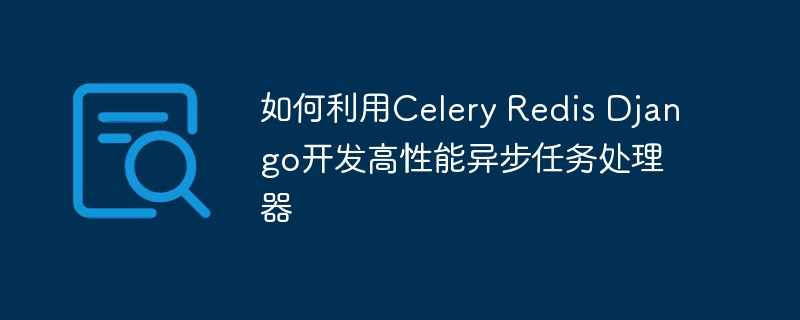

How to use Celery Redis Django to develop high-performance asynchronous task processor
Introduction:
In modern web development, asynchronous task processing is becoming more and more important . Traditional synchronous processing often leads to reduced website performance because other requests are blocked while processing time-consuming tasks. The use of asynchronous task processors can effectively solve this problem and improve website performance.
This article will introduce how to use Celery, Redis and Django to develop a high-performance asynchronous task processor, and provide specific code examples.
1. Celery installation and configuration:
# celery settings CELERY_BROKER_URL = 'redis://localhost:6379/0' CELERY_RESULT_BACKEND = 'redis://localhost:6379/0'
Note: CELERY_BROKER_URL and CELERY_RESULT_BACKEND use Redis as the backend for the message broker and result storage.
2. Redis installation and configuration:
# redis settings REDIS_HOST = 'localhost' REDIS_PORT = 6379 REDIS_DB = 0
3. Write asynchronous tasks:
from celery import shared_task
from django.core.mail import send_mail
@shared_task
def send_email_task(subject, message, recipient_list):
send_mail(subject, message, 'noreply@example.com', recipient_list)from .tasks import send_email_task
def send_email_view(request):
# 调用异步任务
send_email_task.delay('Subject', 'Message', ['recipient@example.com'])
return HttpResponse('Email sent asynchronously.')4. Start Celery Worker:
import os
from celery import Celery
from django.conf import settings
os.environ.setdefault('DJANGO_SETTINGS_MODULE', 'project.settings')
app = Celery('project')
app.config_from_object('django.conf:settings', namespace='CELERY')
app.autodiscover_tasks(lambda: settings.INSTALLED_APPS)celery -A project.celery worker --loglevel=info
5. Testing and deployment:
python manage.py runserver
6. Summary:
By using Celery, Redis and Django, we can easily implement a high-performance asynchronous task processor. When developing web applications, you can use asynchronous task processors to handle time-consuming tasks, improve website performance and enhance user experience.
The above is an introduction and specific code examples on how to use Celery, Redis and Django to develop high-performance asynchronous task processors. I hope this article is helpful to you, thank you for reading!
The above is the detailed content of How to use Celery Redis Django to develop high-performance asynchronous task processor. For more information, please follow other related articles on the PHP Chinese website!
 Commonly used database software
Commonly used database software
 What are the in-memory databases?
What are the in-memory databases?
 Which one has faster reading speed, mongodb or redis?
Which one has faster reading speed, mongodb or redis?
 How to use redis as a cache server
How to use redis as a cache server
 How redis solves data consistency
How redis solves data consistency
 How do mysql and redis ensure double-write consistency?
How do mysql and redis ensure double-write consistency?
 What data does redis cache generally store?
What data does redis cache generally store?
 What are the 8 data types of redis
What are the 8 data types of redis




